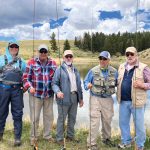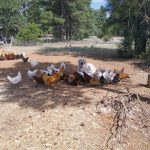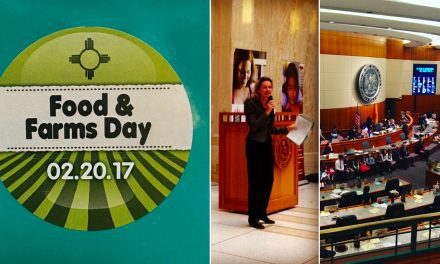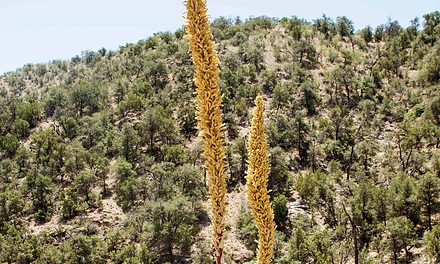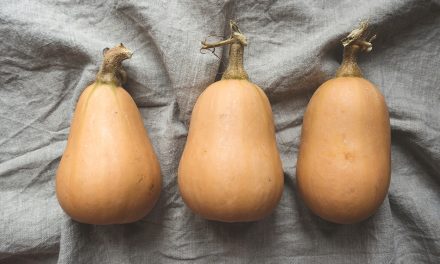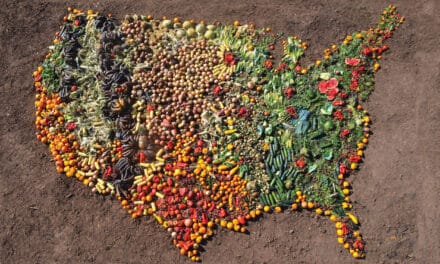Where Wild and Tamed Foodsheds Meet
By Briana Olson

Pollinators visit wild rose near the river in Rio Grande Valley State Park, photo by Briana Olson.
“All the plants are beautiful, Grandma,” says landscape designer and author Judith Phillips, quoting her granddaughter at age three. “What can I eat?”
Phillips, leading a spring tour of the habitat garden planted near the perimeter of the visitors center at Valle de Oro National Wildlife Refuge, offers that when water is a limited resource, maybe that’s the ultimate criteria for what to plant and what to leave alone—not only whether we humans can eat it, but whether anyone can.
The tour is part of Build Your Backyard Refuge Day at the wildlife refuge in Albuquerque’s South Valley, and her focus is on native plants for wildlife gardening. She points out threeleaf sumac as good bee support, horsetail milkweed—“thought to be the main [food] source for monarchs in New Mexico”—and threadleaf sage, which traverses the whole valley, from the West Mesa into the bosque and up to the foothills. But she also mentions that dandelions are good for early bees.
“What is a weed?” she asks. “One definition I like is that it’s a plant in the wrong place. To me, a weed is a weed if it’s so aggressive that it starts pushing out desirable [species].” This points back to some of her first, casual yet grand words on this morning’s tour: “Diversity is the stability of ecosystems.”
Beyond the habitat garden stretch the refuge’s 570 acres of retired dairy farmland. There’s a constructed playa, a demonstration pond, and, near the west edge, young stands of willow and cottonwood. None of this impedes a visitor’s sight lines; even with their heart-shaped leaves yet to grow in, the telltale markers of the Rio Grande bosque draw one’s eye beyond the ditch that helped dry this floodplain, turning it into viable farmland and enabling the development and growth of Albuquerque itself.
Turnout for today’s event is high, and people walk throughout the refuge, but many are drawn toward that majestic, life-giving cottonwood gallery that is approaching the end of its time.
It was early February when, near an entrance to the bosque in Albuquerque, something different caught my eye: a sign flapping against a pile of logs felled as part of a large-scale thinning project designed for fire mitigation in Rio Grande Valley State Park. I had to come close enough to touch the wood in order to read its message: “Please ask for permission BEFORE cutting down trees in their prime. Love, Pachamama.”

Logs felled for fire-mitigation project in Rio Grande Valley State Park, photo by Briana Olson.
Many logs in the pile, as in similarly dramatic stacks closer to Central Avenue, were the trunks and limbs of Siberian elm trees, classified by the New Mexico Department of Agriculture as category C noxious weeds and well known both for the shade they provide and for the prolific edible seedpods, samaras, that soar through spring winds to germinate any- and everywhere they land. (“I tell my friends to eat as many as possible,” one person I interviewed said wryly.) But the person identifying themselves with Mother Earth did not distinguish between native trees and non.
“Was it you?” a friend wrote, forwarding me a report on the colorful signs that went up soon after the first. The answer was no, but I had contacted the Bird Alliance of Central New Mexico to see if they knew about the project. I’d dug up a draft of the proposal, spearheaded by Albuquerque Fire and Rescue, for which FEMA had awarded about a million dollars to cover the removal of “ladder fuels,” targeting “invasives”—Siberian elm, salt cedar, Russian olive, tree of heaven—in the 400 acres of bosque that crown downtown Albuquerque. I had reached out to people near and far from the project, seeking information, direction, and solace for what felt, at least initially, like unwilding.
Visiting the first area cleared, I found the earth riddled with stumps. Despite a few remaining stands of New Mexico olive, the area felt bleak, torn open. With so much of its understory shorn, the loose canopy of elderly cottonwoods was suddenly thrown into relief. What would be left when they were gone? More immediately, how did the coyotes and porcupines, the thrushes and flycatchers, feel about the sudden disappearance of so many prospective meals and perches? In this warming, drying region, might invasive plants be better than none?
In the worst-case scenario, fire would have torn through this vulnerable riparian forest—but what would be the best?

Planting yerba mansa in the bosque, photo courtesy of Yerba Mansa Project.
“Before starting Yerba Mansa Project, I’d walk through the bosque and I was very aware of what was dying,” Dara Saville tells me as we walk through an area where the nonprofit has led community-driven restoration efforts since 2014. “As an herbalist, I hear from a lot of people with climate grief,” she says. “Now we’re active agents healing it.” Twice a year, volunteers participate in a bosque restoration field day, removing ravenna grass by hand and planting native plants that will be watered for three years by a site-caretaking crew. “We do this out of love,” she says of her all-volunteer staff. “Community caretaking of land is an antidote to all of this grief.”
“We plant things to nourish the land,” she says. “What animals need, it’s the same thing we need.” Kneeling to rub yerba mansa leaves near a wildlife pond built by the Army Corps of Engineers, Saville invites me to smell the plant’s medicinal aroma as she talks about its detoxifying properties and its historic role in stabilizing soil after the disturbance of floods. Wild rose, or Woods’ rose, as I’ve learned from Phillips at Valle de Oro, can also stabilize streambanks. Butterflies and bees use the pollen, birds eat the fruit, and herbalists collect it because it’s high in vitamin C. “When you think of plant medicine as ecological medicine—we are this external world, this world is us,” says Saville.
Saville, like Phillips, draws my attention downward. “I’m very big on shrubs,” she says. “They provide food, they provide medicine, they provide shelter. They stabilize the land. And also, they seem to be doing well.” Coyote willow is an important medicine plant; golden currants are nutritionally dense; sumac is cherished by humans. She shows me a false indigo, a plant in the pea family, that Yerba Mansa Project volunteers planted a couple of years ago. “They look like mermaids in the bosque,” she says of their clustered flowers.
Speaking to people’s relationships with plant medicine in New Mexico, Saville, who also founded the bioregional herbal studies program Albuquerque Herbalism, notes that “traditions with plants are much more alive here.” She points out that Russian olive, too, is revered in some places, but we don’t have the cultural context. “Blaming Russian olive is a fallacy,” she adds. “We are the ones who created a situation where it can create monoculture.”

Great blue heron with fish near Tingley, photo by Cheryl Burns.
“There’s a moment in Albuquerque history where they disconnected the river from the city,” John Fleck tells me, describing the construction of the levees and drains that began to lock the once-meandering Rio Grande into its current path. Fleck, who describes himself as a “writer turned water policy scholar,” is writer-in-residence at the University of New Mexico’s Utton Transboundary Resource Center and co-author of a forthcoming book that is “a history of Albuquerque through the lens of how we came to make our peace with the Rio Grande.” He marvels that there’s no record of people talking about this wholescale transformation of the valley. “Most of the discourse around that time, the river was a menace.”
“Los Poblanos field was a lake—swampy,” he says. The ditches that run parallel to Second Street, Rio Grande Boulevard, and the river itself served to lower the water table and drain the fields. He directs me to a UNM student’s master’s thesis that, in 1935, documented this ecological transformation. “The entire ecosystem of the valley floor was completely sacrificed,” he says. “They wanted to build a city—and to be fair, I love my city.”
High-impact farming and grazing upriver, along with deforestation, had led to an accumulation of sediment, raising the floor of the riverbed. Increased flooding ensued.
“The Bureau of Reclamation came in a second time in the 1950s,” Fleck tells me, and “in some places they literally dug a new channel,” installing lines of jetty jacks that slowed the river’s flow and allowed sediment to build up so the river would have a narrower channel. Cottonwoods, whose tiny seeds love wet, open earth, thrived on these new banks—at least at first. So, over time, did long-established Russian olive and salt cedar. It was not strategic planning by plant armies but the very irrigation network upon which many of us depend that enabled Russian olives and salt cedars to populate the now-fixed riverside.
“The problem now,” Fleck says, “is that it can get super choked with non-native species,” which creates a fire hazard—and “also, as a human, I can’t get to my river.” (To wit, three bosque fires were reported as I was writing this article.) Also, with the river restrained and the water table continuing to drop, natural conditions favorable to the growth of cottonwoods—flood-scoured land with fresh deposits of sediment and access to sunlight—no longer exist.
“I can tell you what I think,” Fleck says when I ask about his vision for the future, “but this is a question of community values. Where do we have the community conversation about desired future conditions for this ecosystem?”

Young cottonwoods at Valle de Oro National Wildlife Refuge, photo by Briana Olson.
“If we’re going to have bosque, we’re probably going to have to farm it,” says restoration ecologist Cameron Weber as we circle the perimeter of the long, shallow bioswale that runs through Valle de Oro. Moments later, we move along stands of healthy young willows and cottonwoods, all planted right into old alfalfa fields along with hundreds of other shrubs—wolfberry, four-wing saltbush, false indigo, threeleaf sumac—that provide seeds and berries and nesting materials. Water from the morning’s irrigation is still soaking into their roots.
Weber directs the habitat conservation program at Rio Grande Return, a nonprofit devoted to restoration of riverscapes and ecosystems in the Southwest, and much of her work focuses on “constructed habitats in the footprint of agriculture.” That includes Valle de Oro and much of Candelaria Nature Preserve, a 167-acre property owned by the City of Albuquerque and managed, like Rio Grande Valley State Park, by the City’s Open Space division. We talk about the difficulty of establishing a saltgrass meadow where it’s not hydrologically connected, the tastiness of Indian rice grass (“I like to pop it like popcorn,” she says, as can be done with amaranth), and the challenges in funding this refuge where, in contrast to the typical wildlife refuge that acquires “amazing habitat,” “the land put into the refuge was extremely productive, heavily chemically treated alfalfa.” When Rio Grande Return did a soil seed-bank analysis here, they learned that the native seed bank had been decimated.

Weeding a field of sunflowers and foxtail millet grown as a wildlife crop at Candelaria Nature Preserve. Coyotes, cranes, geese, and songbirds feed on the millet, which also serves as shelter and builds soil health. Photo courtesy of Friends of Candelaria Nature Preserve.
At Candelaria Nature Preserve, plans to rewild aim to transform the North Valley preserve from similarly hard-worked farmland to “a mosaic of habitats that will support diverse native species.” This doesn’t mean returning the land to the conditions of 1926 or 1489 but creating habitats that are missing from the area due to urban expansion. As at Valle de Oro, some of those will be wetlands that mimic the historic floodplain while others represent dryland plant communities—in Weber’s words, “climate-appropriate habitat that will endure for decades.” Mesquite, planted in basins characteristic of Chihuahuan Desert habitat, would have been present historically but not widespread, Weber says, adding that within her lifetime, it’s likely that Albuquerque will come to experience a climate more like that of Las Cruces. One key difference between the two projects is that at Candelaria, not all the plants grown are native, and several fields are devoted specifically to agricultural crops grown to support wildlife, especially protected migratory birds such as the greater sandhill crane.
“The driving story is urbanization and wildlife,” says Jeannie Allen of Friends of Candelaria Nature Preserve, a group that lovingly helps steward the work there and offers public tours once a month. The first time I visit, they’re getting ready to plant thirty species of pollinator plants—“globemallow is the hero because its roots are long”—in a field that’s been cleared of johnsongrass and bindweed and remediated with gypsum, kelp, and chicken feathers. Oats’ root structure is good for soil health, Weber notes, plus they provide grain for birds. Returning for a birding tour led by the Bird Alliance, I watch bluebirds and phoebes dance through a field of sunflowers and cover crops. A spotted sandpiper moves along the edge of a pond, picking invertebrates from the flattened reeds.
Back at Valle de Oro, Weber points out a Swainson’s hawk, then a kestrel. Yes, she acknowledges, thickets of Russian olive and salt cedar can create habitat for the “swiffle” (a.k.a. the endangered southwestern willow flycatcher), but the reedlike coyote willow along the edge of the swale has more insect associations. She explains how this entire bioswale could fill like a bowl after a big storm, and a portion of Albuquerque’s stormwater was specifically redirected to flow here. In this way, the refuge provides a service to the city. “Soil microbes are the best agents for treating pollutants,” she says. “There are outflows where polluted water goes straight into the river—that’s the worst. Here the soil is cleaning the water before it reaches additional wetland treatments” in the bosque just beyond the refuge boundary.
“The bosque is a sponge,” says Yasmeen Najmi of the Middle Rio Grande Conservancy District. She identifies the bosque as a user of water—“any riparian system or any ecosystem that’s next to a stream is there because it depends on water”—but she also observes that the bosque helps clean and add nutrients to the water that passes through the Middle Rio Grande Valley. While she notes that this is not part of the Rio Grande Compact’s mandate, when I ask if there’s any way that the bosque benefits the human foodshed, she points out that surface water rights in the Middle Rio Grande valley and the compact’s requirement to deliver water down south indirectly support the bosque, which in turn provides pollinator habitat, stores water, and acts as a kind of filtration system, among other benefits for agriculture.
“Riparian areas are less than 2 percent of land areas in the Southwest and probably shrinking, so what happens with the bosque and the way we manage it is really critical,” Najmi says. This is true not only for human users of the rivershed but for the animals who rely on it, whether during migration or for their entire lives. She echoes many others in observing that current and future conditions—climate change, dropping water tables, changes in surface water supply—don’t support natural regeneration and may not support native species.
“We know that all of our ecosystems have been used for thousands of years for food and medicine,” says Najmi, who practices herbalism in her off time. Speaking as a land manager, she emphasizes the importance of communicating plant knowledge and harvesting ethics, noting that she grows native herbs in her yard and harvests yerba mansa from a friend’s farm rather than in the bosque. At the same time, “the cultural connections to the Rio Grande and the bosque are important, and it’s important for us to respect that.” While she might eat wild verdolagas, or purslane, a plant introduced from Eurasia, “when I make medicines, I try as much as possible to use native plants.”
Birds, though, tend to be opportunists. In one project Najmi led, the US Forest Service monitored research sites for changes in groundwater, wildlife use, and vegetation, ultimately gathering key information about how land management may affect birds. “What we learned is that there are whole segments of the bird population that key in on what we call midstory canopy shrubs, like Russian olive and salt cedar.” Removing those shrubs can lower bird numbers, she explains, “but not necessarily long term.”
“What we know from bird surveys is that Russian olive is one of the plants that supports one of the highest numbers and diversity of birds in the bosque. Also New Mexico olive, and berry plants. My philosophy at this point is that we’re not going to eradicate them, but they do need to be managed,” she says. “And where we have opportunities to replace them with New Mexico olive, we do that.”

White-breasted nuthatch hunting for insects in a cottonwood, photo by Cheryl Burns.
White-crowned sparrows and goldfinches may be as happy to eat Russian olives as New Mexican ones, but as I’ve learned from biologist/ecologist Mary Harner, who studied the cottonwood forest along the Rio Grande with the late Cliff Crawford and others as a doctoral student at UNM, Russian olives can fix atmospheric nitrogen. Not only can they survive nutrient-poor soils, but “their leaves have a higher nitrogen content than the native cottonwood trees, and that has effects on nutrient cycling in the soil.” Still, Harner notes that both native and nonnative plants provide food and other resources used by birds, and a 2010 report for the US Geological Survey points at the need for more research on how removing salt cedar and Russian olive may impact species from cuckoos to bats to cicadas. Beavers and porcupines may be the most visible fans of munching on cottonwoods, but Harner highlights the arthropods, both the winged ones that use the canopy and the ground-dwelling ones that use the organic matter built from leaf fall on the forest floor.
In her 1935 master’s thesis, UNM student Mary Van Cleave cataloged the many habitats that existed in the Middle Rio Grande Valley before the river was tamed: from swamps full of watercress and protein-rich sedges to saltgrass meadows to scattered inland stands of grass-woodland bosque. Mosaic is the term often used to describe this lost patchwork of habitats. It’s also a word land managers and stewards often use to describe their visions for the future. On occasion, it has seemed to represent fantasy or nostalgia or even a euphemism for the death of the bosque as we know it. But the term can also signal possibility. The community-driven efforts at Candelaria and Valle de Oro offer an argument both for investing in the native bosque and converting some retired farmland to homes for wildlife instead of humans.
Resisting the narrative that “the bosque is dead,” Weber also points at the success of bank-lowering projects that bring the floodplain down to the river and support the regeneration of cottonwoods. Najmi mentions a backwater project where yerba mansa and cottonwoods grew in after a fire. And Dustin Chavez-Davis, project coordinator for Open Space, is hopeful that cottonwoods can be established through pole plantings in areas where the Ancestral Land Conservation Corps is actively clearing ravenna grass.


Porcupine and toad in the bosque, photos by Briana Olson.
We’re standing near a willow swale constructed by the Army Corps a decade or so ago, flanked by a thick stand of New Mexico olive and a thicket of wild rose, when Chavez-Davis turns to what might be one marker of a project’s success: the disappearance of its traces.
“It’s just amazing to me how many projects there are within our Albuquerque reach,” he says, “that I didn’t know [were] restoration projects before I got this job.” What feels like nature when we’re out walking “is not necessarily a natural system—I mean, it is, but we’ve had so many interventions along the way.” He mentions the Yerba Mansa Project and talks about how restoration work can blend in over time, how golden currant and sumac were planted and watered by volunteers carrying buckets until the plants got established, and then three or four years later, they’re thriving shrubs.
Gift, love, fortune, opportunity, incredible resource, fresh air, crown jewel: these are a few of the terms people have used in describing the bosque to me. Yet the Open Space division manages more than 30,000 acres with just forty-three staff, including a single field biologist, and the 4,300-acre Rio Grande Valley State Park is arguably underresourced. What if Albuquerque (and New Mexico) valued its bosque as much as New York City values Central Park? “In my dream world,” says superintendent of Open Space Colleen Langan-McRoberts, “we would have a dedicated, sizable staff to be in the bosque all the time, seven days a week.”

Morel found in the bosque at a Yerba Mansa Project restoration field day, photo by Briana Olson.
At the Yerba Mansa Project’s Bosque Restoration Field Day in mid-May, the best find might be when one volunteer unearths a morel. A kid later shows off the “mudshrooms” they’ve fashioned while we were hacking at the grasses. But the greater satisfaction is in discovering a straggling young cottonwood in the middle of a plume of ravenna grass I’m prying out of the riverbank. (Tip: leave your flimsy garden hoe at home.) Recalling how Saville described kids developing relationships through events like this and wanting to come back and check on what they planted, I consider this tree. It is just one, and hardly in itself a measure of the health (or vulnerability) of all who live off the bosque, but it teaches me something. Focusing on a single tree—or a single species—can skew perspective, but it might also be a means of grounding. And an action that seems too small to matter can.
“I’m working with realistic hope,” Saville tells me. “Given [the conditions that are unlikely to change], which of these plants that sustain our food and medicine and all the beings of this land—which can come with us?”

Briana Olson
Briana Olson is a writer and the editor of edible New Mexico and The Bite. She lives in Albuquerque.


